Everyone loves to watch orchids release flowers. However, often beautiful orchid flowers falling off, which causes panic in the owner. They likely fall off due to the end of the flowering process. More about why orchid flowers fall off will be discussed in this article.
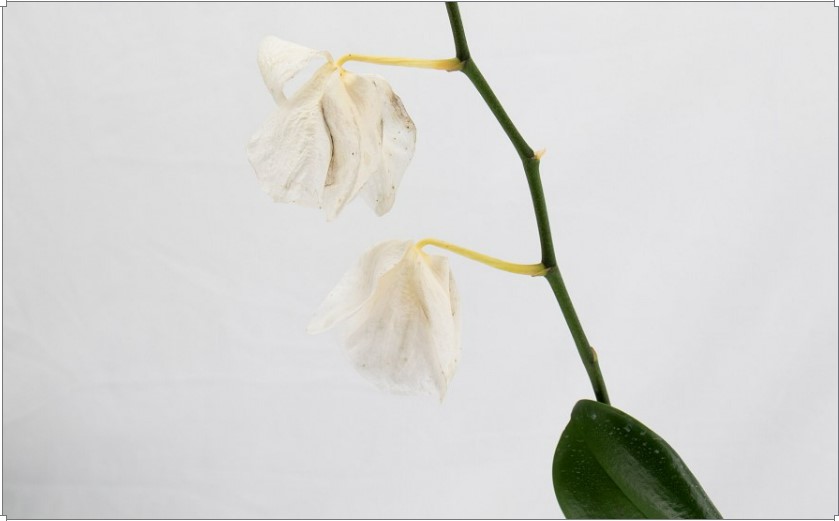
Plant features
Before proceeding to the question of why orchid flowers falling off, you should familiarize yourself with the main features of the culture. It should be noted that in total there are more than 25 thousand different types of orchids. All the flowers differ in appearance and development to attract pollinators. Bright flowers help to seduce insects.
It is thanks to the unusual and beautiful structure of Phalaenopsis orchid flowers that they are so popular among people.
If the culture is properly cared for, the orchid blooms for a long time and is durable.
Orchid life cycle
Like most plants, the orchid has its life cycle. With it, you can determine the best time for feeding or transplanting, as well as other important care steps. You can understand if the fall of the flower is caused by natural causes, or if there is a reason to panic. There are several main stages in the life cycle of Phalaenopsis orchids.
Seeds
In the natural environment, the development of an orchid plant begins with a seed. They are shed by mature plants that have gone through the pollination process. Successful seed growth is possible after months or even years.
Germination
When a seed falls, it starts to germinate. To do this, several basic factors must be provided, including heat, humidity, and sunlight. If all this is observed, the seeds germinate. The process can take 2-6 months. In the natural environment, flowers need fungi that penetrate the cells of the seed. Through them, the flower receives nutrients that promote growth and development.
Growth
Over the next 3-5 years, the plant will grow. First, a new leaf is formed, which will allow it to feed on sunlight. In the next stage, the stem, root system, and other leaves begin to develop. After the formation of the correct system, flowering begins.
Playback
When the Phalaenopsis orchid plant is mature and stable, you may notice the bud blast. The beginning of flowering indicates that preparations for reproduction are taking place. The flower contains both male and female reproductive organs.
Pollination
When flowers appear on the bushes, it attracts not only humans. All flowers differ in shape and shade, which allows them to attract insects. There are varieties with bright flowers that mimic the inflorescences of other plants that contain nectar.
This allows you to attract birds and butterflies. There is no nectar inside orchids. However, the plant uses pollen to deceive insects. After the insects fly to another orchid flower, carrying pollen. This serves the process of pollination.
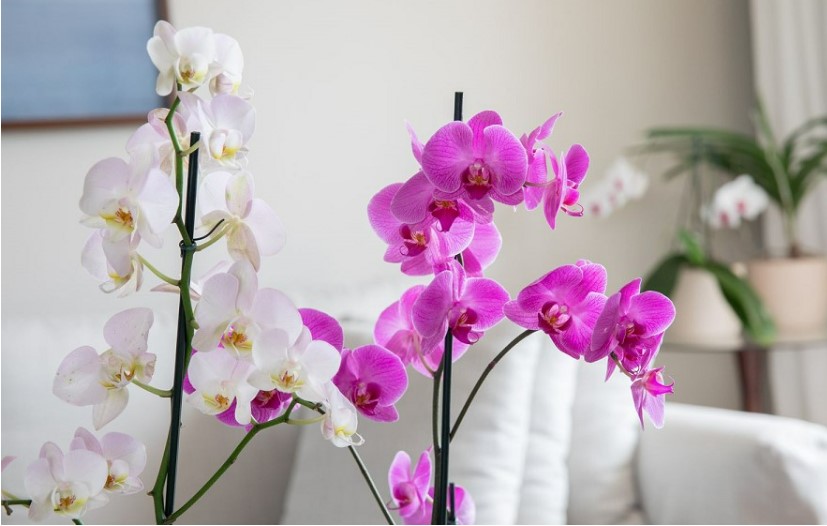
Seed spreading
When the pollination process is complete, the petals will close to allow the seed pod to develop. This process can take weeks or years. Once the development of the pod is over, it will be dropped to the ground. The reproduction will begin after some time, which is required for recovery.
Resting-state
At home, the plant is not pollinated. Then the cycle of life changes a little. The steps do not change until the breeding stage.
As soon as flowering ends, the flower will be dropped, and the plant itself will go into a dormant state.
It may seem that the orchid flower has no strength at all. Roots and new orchid flower buds will not develop, and little watering will be required. However, at the dormant stage, the plant regains its strength. After that, the active development of the orchid roots will begin, after which the flower will begin to appear again.
Blooming cycle
You need to understand that the blooming cycle depends on the type of orchid. The home variety, called Phalaenopsis, blooms for up to 90 days. Other species may bloom for no more than a month. However, the health of the plant also affects the duration of flowering, so you must provide it with proper care.
Flowering frequency
On average, tropical plants are dormant for 2-6 months. After that, an awakening occurs, and you can see the growing orchids again. In most cases, bushes bloom only 1 time per year. Phalaenopsis do not have a dormant period, so orchid blooms 2-3 times a year.
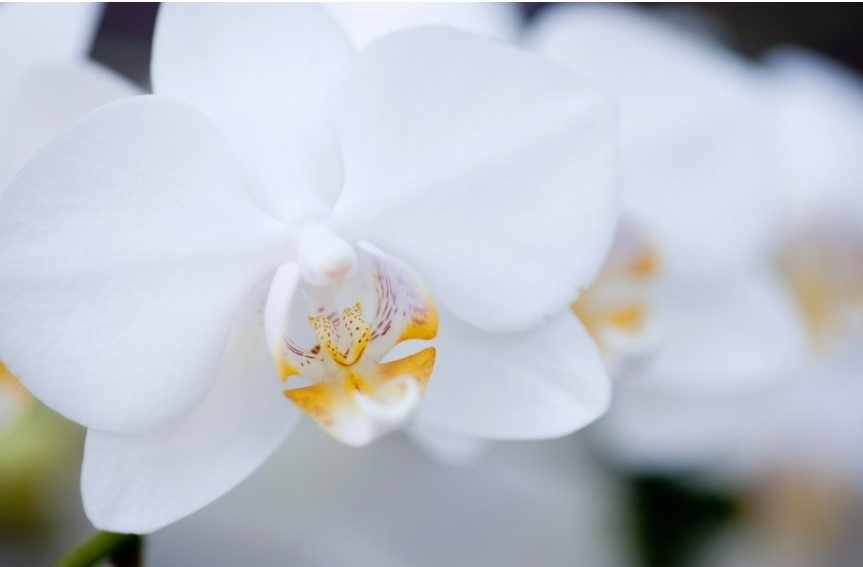
Why do orchid flowers fall off the stem?
The fall of a blooming orchid is a completely natural process. After all, the flowering stage has ended, and the plant is preparing for a state of rest.
If the flowers fall off the brown stem
Often people notice that the flowers fall from the brown stems. In this case, pruning of the plant will be required. If the stem darkens, then part of the bush has begun to die. This is no reason to panic. This is because the bush no longer needs this part.
You can discard the stem along with the fallen flower. After pruning, the plant will save energy and will be able to direct its growth. If the bare stem has turned brown, it must be completely removed.
To do this, arm yourself with sharp scissors. At the bottom of the stem, you need to make an incision, touching the very base. This will allow the branch that dies off, as well as direct all the energy of the orchid flower into the growth of the root system. Thanks to this, the plant will bloom more abundantly in the coming season.
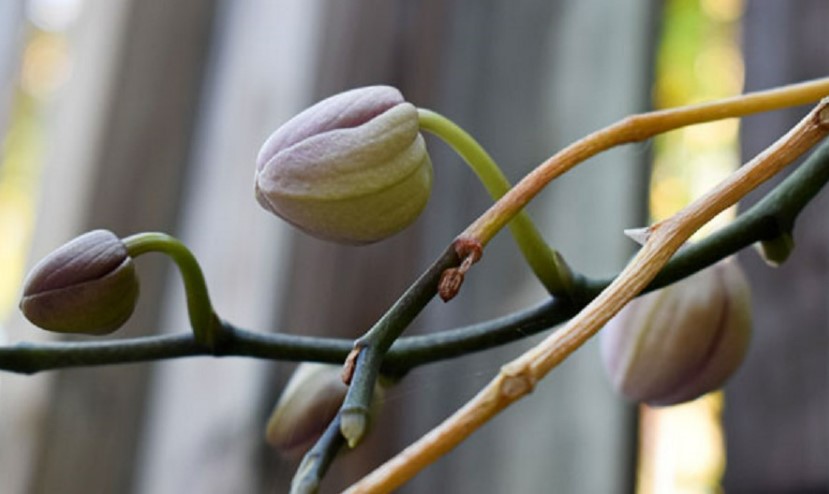
Why do flowers fall and leaves turn yellow?
Often the fall of blooming orchid flowers is caused by the yellowing of the leaves.
Abundant watering
Yellowing of leaves and orchids flowers falling can be caused by waterlogging of the soil. The more water you add, the more likely the plant will die. Due to improper watering, the health of the orchid deteriorates. Therefore, it is necessary to study in advance the features of caring for a culture so as not to harm it.
If the flowers have fallen off, and the leaves have turned yellow, you must immediately check the root system. It is important to understand whether it was affected by root rot. It is not difficult to determine the disease, because dark green, brown, or black roots and flower spikes testify to it.
If the root system is soft, then you watered the plant abundantly.
You should start restoring the culture so that the orchid does not die. To do this, cut off all the roots that were affected, dry the rest, and proceed with the transplant. For the cut points to heal faster, open roots should be treated with a solution of water and hydrogen peroxide.
Transplanting should be carried out in airy soil, supplemented by good drainage. This allows the water to disperse so it doesn’t accumulate.
Too much light
Often the yellowing of the leaves is because the plant receives too much sunlight. Orchids need to be placed in places with good lighting. However, direct sunlight should be avoided. Try to create conditions for a culture that will be as close as possible to the natural environment.
You need to choose a humid and warm place into which diffused sunlight penetrates. To do this, you can put the orchid pot on the window in the bathroom, which faces north or east. You can also install an orchid in a well-lit kitchen. Periodically, you need to spray the bushes so that they are moist, but not wet.
Cold
Often the yellowness of the leaves is because the plant is in a cold room. If the bushes are cool at night, this will start the flowering process. If the plant is constantly in the cold, negative reactions can be observed.
There are several types of orchids, depending on the temperature regime: warm, medium, and cool. It is important to determine which species you have and provide it with the right conditions.
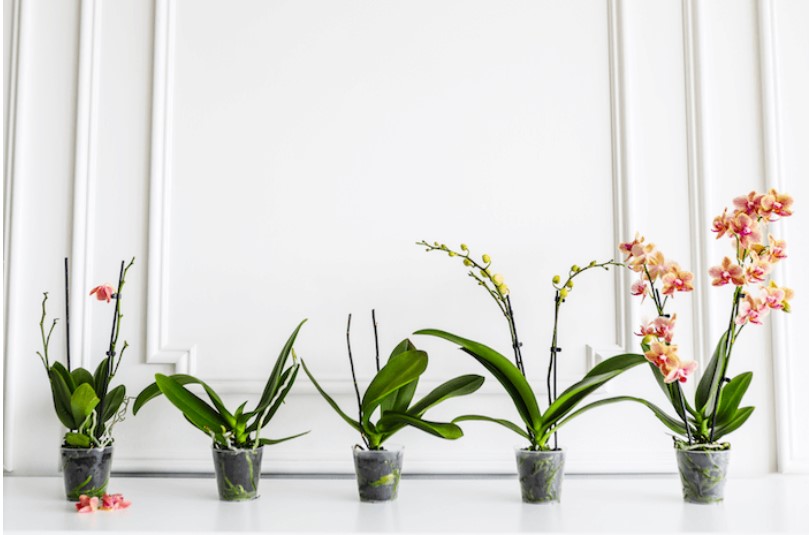
Falling off orchid flowers from yellow stems
Often, after the flowers fall, the flower stems begin to turn yellow. This indicates that the stem is over. If it began to turn yellow and wrinkle, it should be cut off at the very base. Because it won’t bloom again.
Fall of flowers before flowering
If the flowers falling off when the flowering process was completed, this is a natural process. There will be a reason for panic if this happened before the flower has blossomed. This can happen for several reasons, which will be discussed below.
State of stress
If you notice that flowers are falling from the flower spike, then they are subject to severe stress. Try to inspect the bushes every day to determine if you feel unwell in time. Stress can happen for various reasons, which will be discussed below.
Moving
Orchids like to be in one place. If they are moved to another room, the reaction may be negative. Yes, the stress will be temporary. However, it is better to refrain from moving. If you plan to move the flowerpot to conditions more suitable for the orchid, this will be a plus. Over time, the bush will recover and will delight you with more abundant flowering.
Sudden change in temperature
Flower spikes do not like it when the air temperature is constantly changing. At night, readings should be 20 degrees Fahrenheit lower than during the day. However, during the day or night, the temperature should be stable. Only a smooth change in temperature will be appropriate for orchids.
You may think that the room temperature is stable. However, the orchid is considered a sensitive plant. Therefore, even a slight deviation from the norm can cause stress. Because of this, the orchid buds will fall off. Several reasons can provoke a temperature change:
- an open window near the plant;
- constant operation of the air conditioner;
- proximity to a heat source (radiator, fireplace, or heater);
- long stay on the street;
- constant heat from the oven;
- direct rays of the sun;
- drafts.
The presence of chemicals in the air
Often, the bud blast falls from the bushes because there are too many aggressive chemical components in the air. As already mentioned, orchids are quite sensitive, so they can react dramatically to changes in air quality. Most orchids are considered epiphytes. Therefore, they can absorb nutrients from the air.
If there are chemical components in the air, this can cause poisoning of the bush, which causes buds to open. Avoid using perfumes, air fresheners, paints, solvents, or fabric softeners near orchids.
Also, do not smoke near the plant, or expose it to gas. Even scented candles that are artificially scented can be harmful to orchids. Therefore, in a room with flowers, it is better to refuse them.
Water temperature
The sensitivity of orchids not only to air temperature is noted. You should pay attention to the temperature of the water for irrigation. If you water the plants with excessively cold or hot water, the flower will experience stress. Because of this, the flowers will begin to drop, and the bush will go into a dormant state.
Some gardeners advise placing ice cubes on the ground. This is a great option for slow watering. However, due to the sensitivity of the root system, this can harm the plant. Watering should be done every 10 days. Every day you need to spray the bushes. The water should be at room temperature.

Sudden fall of orchid flowers
You can start to worry if the flowers from the flower spike began to fall off suddenly. If the plant’s life cycle is approaching the end of flowering, this situation will be normal. If flowering is just beginning, then the fall of the inflorescence indicates stress. It is important to properly monitor orchids, following a few tips, namely:
- keep flowerpots away from open windows or ventilation;
- don’t put flowers next to fruits.
When fruits ripen, they begin to release ethylene. This gas can cause the flowers to drop from the bush.
Read also: Healthy orchid roots
Premature flower drop
If you are waiting for the orchid to bloom on a flower spike for a long time, and the flowers began to fall quite early, then the plant is trying to go into a dormant state for its safety.
This can be due to various reasons, which will be discussed below.
Root rot
Most often, orchids are affected by root rot. It can be caused by abundant watering. However, other reasons can provoke the disease, namely:
- absorbent soil;
- the non-breathing container;
- insufficient lighting;
- stay of the flower in the cold.
To save the plant, you should start pruning the roots that have been affected. As already mentioned, transplanting into a container filled with well-drained soil will be required. It should be noted that root rot can provoke stress. So give the plant time to recover.
Improper watering and fertilizing
A plant that is trying to bloom should not be exposed to drought for a long time. Because of this, the flowers can be dropped, because they will not have enough nutrients. Therefore, you need to soak the roots, and then spray. However, this will not allow the flowers to be saved.
Read also:
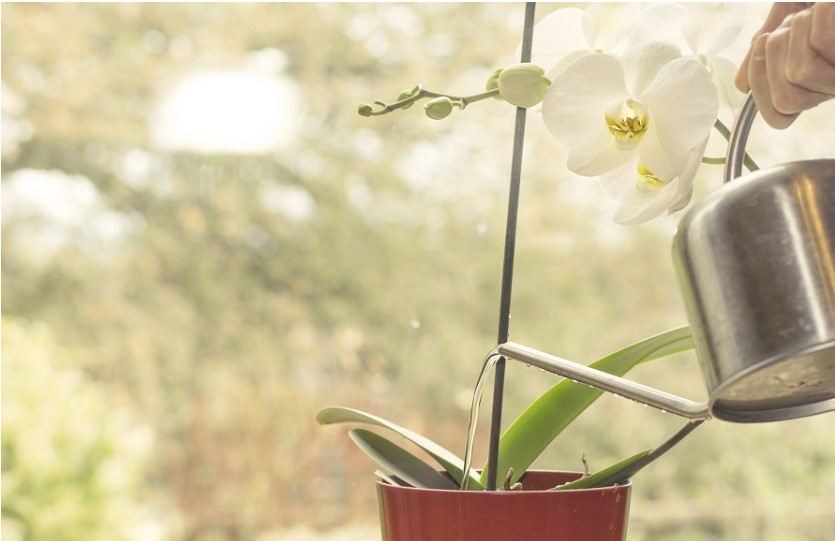
FAQ
When it comes to growing orchids, there are a few questions you may be faced with. The answers to them will be presented below.
Do orchids grow back after the flowers fall off?
You need to understand that orchids do not bloom once in a lifetime. Repeat flowering is possible if you properly care for the plant.
How long does it take for an orchid to rebloom?
The duration of the dormant stage is about 6-9 months. During this time, the plant accumulates nutrients, which later will allow the formation of new and beautiful inflorescences.
Results
As you can see, the fall of orchid flowers occurs for various reasons. In most cases, they are caused by improper care.
Read also:
Do orchids grow back after the flowers fall off?
Yes, orchids can grow back after their flowers fall off. The plant will enter a resting period before growing new flowers or developing new growth.
What do you do to an orchid when the flowers fall off?
When the flowers fall off an orchid, you can cut the stem just above the node where the first flower bloomed. This will encourage the plant to produce new growth and potentially new flowers in the future. Additionally, you should continue to care for the plant by providing it with proper light, water, and fertilizer to support its growth.
How long does it take for an orchid to rebloom?
The time it takes for an orchid to rebloom can vary depending on several factors such as the type of orchid, its growing conditions, and how well it is cared for. On average, it can take anywhere from a few months to a year or more for an orchid to rebloom after its flowers have fallen off.
What month do orchids lose their flowers?
The specific month in which orchids lose their flowers can vary depending on the species and the plant’s growing conditions. However, in general, orchids tend to bloom for several weeks to a few months at a time, and their flowers will eventually naturally fall off once they have completed their bloom cycle. This can happen at any time of the year, depending on when the orchid was last in bloom.
How often should I water my orchid?
The frequency of watering an orchid depends on several factors, such as the type of orchid, its growing conditions, and the type of potting medium used. In general, it is recommended to water orchids once a week, but this can vary depending on the factors mentioned above. Before watering an orchid, it’s important to make sure that the potting medium has completely dried out.
What does a resting orchid look like?
A resting orchid may appear to have no new growth, and the leaves may look dull or slightly yellowed. The plant may also shed its older leaves and may not require as much water or fertilizer during this time. This is a normal phase for orchids as they prepare to enter a new growth phase and potentially produce new flowers.

